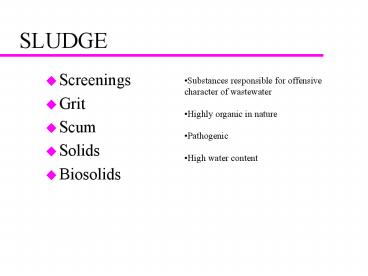SLUDGE - PowerPoint PPT Presentation
Title:
SLUDGE
Description:
Reduce water content, organic content and render solids ... Alcohols, hydrogen, CO2,formate, acetate. Process Microbiology. Methanogens or Methane Formers ... – PowerPoint PPT presentation
Number of Views:260
Avg rating:3.0/5.0
Title: SLUDGE
1
SLUDGE
- Screenings
- Grit
- Scum
- Solids
- Biosolids
- Substances responsible for offensive character of
wastewater - Highly organic in nature
- Pathogenic
- High water content
Reduce water content, organic content and render
solids suitable for reuse or final disposal
2
Sludge Management and Disposal
- Thickening, Conditioning
- gravity, flotation
- Dewatering, Drying
- Vacuum filtration, centrifugation, pressure
filtr. - Digestion, Composting, Stabilization
- aerobic, anaerobic, alkaline treatment
- Disposal
- land application, burial, incineration
3
REGULATIONS
- 40 CFR 503
- Land application of sludge (Class A and Class B)
- Surface disposal
- Patogen and vector reduction
- incineration
4
Volume Mass Relationships
Specific gravity of solids
Specific gravity of solids
5
THICKENING
- Increase the solids content of sludge by removing
a portion of the liquid fraction - Activated sludge 0.8 to 4 results in fivefold
decrease in sludge volume - Settling, flotation, centrifugation, gravity
belt, rotary drum
6
Sludge Dewatering
- Sludge drying beds
- historically the most common
- sand bed, 15-30 days, evaporation seepage
- Vacuum Filtration
- cylindrical rotating drum covered with fabric
- submerged with applied vacuum
- Continuous belt filter presses (follows)
- Plate pressure filters
- vertical plates mounted on a frame
7
Belt Filter Press Description
In the belt press process, chemical conditioned
sludge is resting on a gravity drainage section
so that it can be thicken. Water is able to fall
from the sludge by the force of gravity. Now
pressure is being applied in a low pressure
section, where the sludge is squeezed between
opposing porous cloth belts. Next it will travel
through a high pressure section, where the sludge
is subjected to a shear force as the belts pass
through a series of rollers. This shearing force
and squeezing process reduces additional
quantities of water from the sludge. Finally
dewatered sludge cake is removed from the belts
by scraper blades.
8
Belt Filter Press (Komline-Sanderson)
9
Filter Press
10
Sludge Volume Reduction
A. Start with 1 liter of 1 by weight (i.e., 10
g/L) sludge. Mass of sludge (1 liter)(1000 g/L)
1000 g sludge Mass of solids (1 liter)(10
g/L) 10 g dry sludge solids Mass of water
1000 g - 10 g 990 g H2O
B. Gravity Thicken to 4 dry solids (i.e., 40
g/L). Mass of sludge (10 g)/(0.04) 250 g
sludge Mass of solids unchanged 10 g dry
sludge solids Volume Removed (1000 mL - 250
mL)/1000 mL 75 Mass of water 250 g - 10 g
240 g H2O
C. Vacuum Filter to 30 dry solids (i.e., 300
g/L). Mass of sludge (10 g)/(0.30) 33.3 g
sludge Mass of solids unchanged 10 g dry
sludge solids Volume Removed (1000 mL - 33.3
mL)/1000 mL 96.7 Mass of water 33.3 g - 10 g
23.3 g H2O
11
Aerobic Digestor
12-20 days of aeration 50 reduction in solids
12
Digester
13
Anaerobic Digestion
- Sludge held without aeration for 10-90 days
- Process can be accelerated by heating to 35-40oC
- These are called High Rate Digestors (10-20 days)
- Advantages
- low solids production
- useable methane gas produced
- Disadvantages
- high capital costs
- susceptibility to shocks and overloads
14
Conventional standard rate single-stage
High rate Completely mixed single-stage
Two-stage Process
15
Process Microbiology
Lipids, Proteins, Nucleic Acids, Polysaccharides
Hydrolysis
Acidogenesis
Fatty Acids, Amino Acids, Monosaccharides etc
Alcohols, hydrogen, CO2,formate, acetate
Methanogenesis
Methane and Carbon Dioxide
16
Process Microbiology
- Methanogens or Methane Formers
- 4H2 CO2 CH4 2H2O
- 4HCOOH CH4 2H2O 3CO2
- CH3COOH CH4 CO2
- CH3OH 3CH4 CO2 2H2O
- 4(CH3)3N H2O 9CH4 3 CO2 6H2O 4NH3
pH 6.6-7.6, alkalinity should be present slow
growth rates Y 0.06
17
Digester Design
- Mean Cell Residence Time
- Volumetric Loading Factor
- Observed Volume Reduction
- Loading Factors Based on Populations
18
Toxics in Municipal Sludge
Problem with buildup of heavy metals in soil
receiving sludge
19
Ultimate Sludge Disposal































